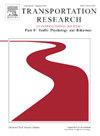解释儿童的身体活动:计划行为理论中的经验态度
IF 3.5
2区 工程技术
Q1 PSYCHOLOGY, APPLIED
Transportation Research Part F-Traffic Psychology and Behaviour
Pub Date : 2025-04-04
DOI:10.1016/j.trf.2025.03.024
引用次数: 0
摘要
儿童的身体活动越来越少,这反映在定期锻炼(如有组织的训练)减少,以及作为一种交通方式的主动机动性(如步行和骑自行车)减少。依靠计划行为理论(TPB),我们关注作为意图决定因素的工具态度和经验态度之间的区别,这是一个在儿童身体活动(PA)方面受到有限关注的问题。与之前对成年人的研究一致,经验态度被发现是体育活动意图的重要预测因素。这些态度对步行和骑自行车的意愿有特别强烈的影响,而锻炼意愿在很大程度上受主观规范的控制。在行为预测中,感知到的行为控制解释了运动中的大部分差异,而意图解释了步行和骑自行车的大部分差异。根据结果,我们得出结论,可能需要不同种类的干预措施来改变参与运动的意图,而不是积极的活动。建议对不同年龄和人口背景的儿童进行进一步研究。本文章由计算机程序翻译,如有差异,请以英文原文为准。
Explaining children’s physical activity: Experiential attitudes in the theory of planned behaviour
Children are becoming less physically active, as reflected in decreasing regular exercise such as organised training, and a decline in active mobility as a form of transportation, such as walking and cycling. Relying on the theory of planned behaviour (TPB), we focused on the distinction between instrumental and experiential attitudes as determinants of intentions, an issue that has received limited attention in relation to children’s physical activity (PA). In line with previous studies on adults, experiential attitudes were found to be important predictors of physical activity intentions. These attitudes had an especially strong impact on walking and cycling intentions, whereas exercise intentions were largely controlled by subjective norms. In the prediction of behaviour, perceived behavioural control accounted for most of the variance in exercising, whereas intentions explained most of the variance in walking and cycling. Based on the results, we conclude, that different kinds of interventions may be required to change intentions to engage in exercise, as opposed to active mobility. Further research with children of varying age and demographic backgrounds is recommended.
求助全文
通过发布文献求助,成功后即可免费获取论文全文。
去求助
来源期刊
CiteScore
7.60
自引率
14.60%
发文量
239
审稿时长
71 days
期刊介绍:
Transportation Research Part F: Traffic Psychology and Behaviour focuses on the behavioural and psychological aspects of traffic and transport. The aim of the journal is to enhance theory development, improve the quality of empirical studies and to stimulate the application of research findings in practice. TRF provides a focus and a means of communication for the considerable amount of research activities that are now being carried out in this field. The journal provides a forum for transportation researchers, psychologists, ergonomists, engineers and policy-makers with an interest in traffic and transport psychology.

 求助内容:
求助内容: 应助结果提醒方式:
应助结果提醒方式:


